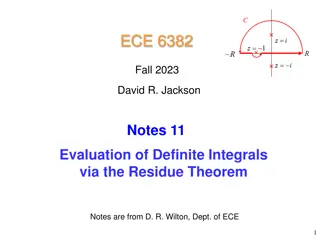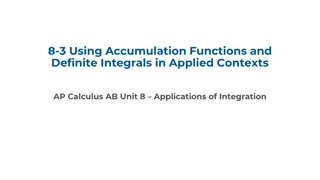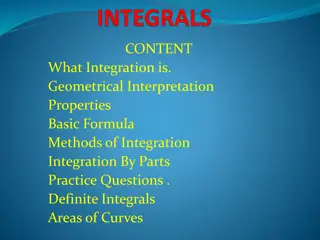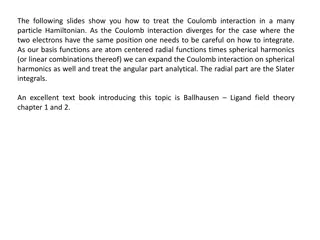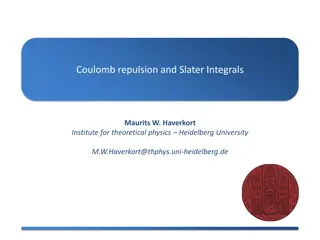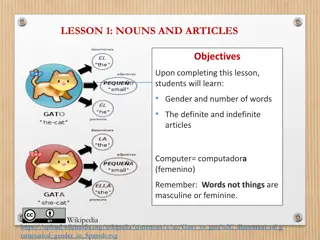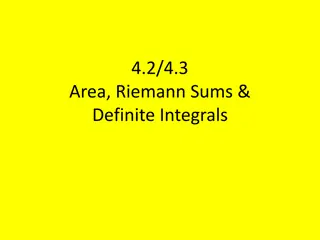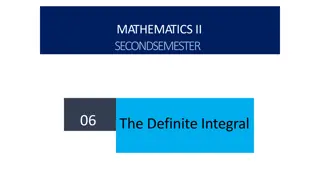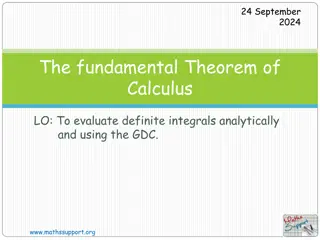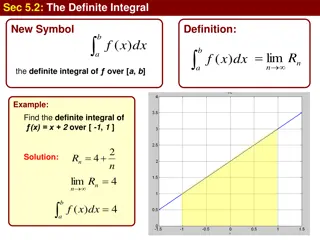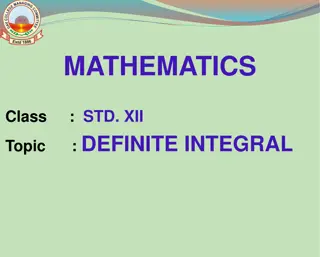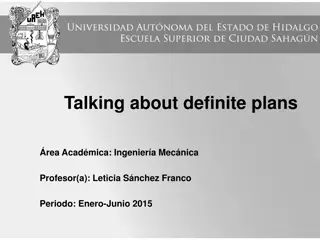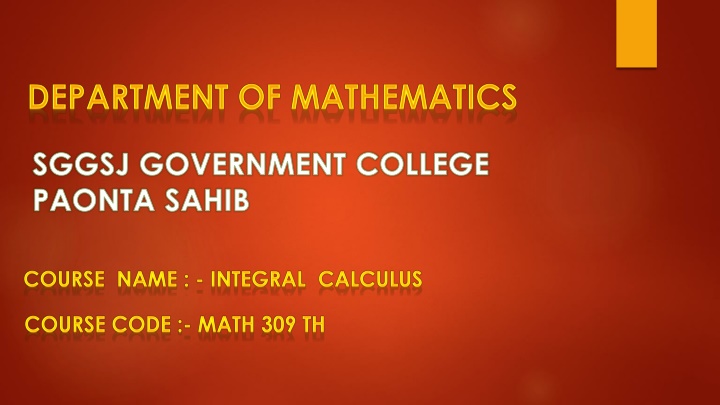
Proving Theorems on Definite Integrals at SGGSJ Government College, Paonta Sahib
Explore mathematical theorems on definite integrals at SGGSJ Government College, Paonta Sahib, with detailed proofs and explanations. Understand concepts such as definite integral properties and their applications in solving mathematical problems.
Download Presentation

Please find below an Image/Link to download the presentation.
The content on the website is provided AS IS for your information and personal use only. It may not be sold, licensed, or shared on other websites without obtaining consent from the author. If you encounter any issues during the download, it is possible that the publisher has removed the file from their server.
You are allowed to download the files provided on this website for personal or commercial use, subject to the condition that they are used lawfully. All files are the property of their respective owners.
The content on the website is provided AS IS for your information and personal use only. It may not be sold, licensed, or shared on other websites without obtaining consent from the author.
E N D
Presentation Transcript
SGGSJ GOVERNMENT COLLEGE PAONTA SAHIB
Theorem 1: On Definite Integral Theorem 2 : On Definite Integral Theorem 3 : On Definite Integral Theorem 4 : On Definite Integral Theorem 5 : On Definite Integral Theorem 6 : On Definite Integral Theorem 7 : On Definite Integral
b b dx = = f( z ) a Theorem 1: Prove that f(x) f(x) dx f( z ) dz dz a Proof . Let f ( x ) Now L.H.S = = f (x) R.H.S R.H.S = [ (z) ] { from eqn. ( = [ (z) ] { from eqn. (1 1) putting x=z, = = (b) (b) (a) (a) L.H.S = R.H.S L.H.S = R.H.S Hence the result Hence the result dx = = ( x ) f ( x ) dx ( x ) . ( . (1 1) ) b b dx = =[ [ (x) (x)] ] = (b) = (b) (a) (a) Now L.H.S f (x) dx a a b a ) putting x=z, dx dx = = dz dz } }
b a Theorem 2 : Prove that f(x) dx = = - - f(x) f(x) dx a f(x) dx b dx Proof. Let f(x) Then L .H .S = f(x) R.H.S = - - f(x) = [ b ] L..H..S = R.H.S Hence the result . f(x) dx dx = (x) = (x) b b Then L .H .S = dx = [ (x) ] = (b) = [ (x) ] = (b) (a) a (a) f(x) dx a a a b dx = = - - [ (x)] [ (x)] = = - - [ (a) = [ b ] [b] L..H..S = R.H.S Hence the result . [ (a) (b) ] [b] R.H.S = (b) ] f(x) dx b
c b b Theorem 3 : Prove that f(x) Proof . Let f(x) f(x) dx L.H.S. = f(x) R.H.S. = = f(x) = =[ (c) L..H..S = R.H.S Hence the result dx = = f(x) dx + + f(x) c f(x) dx f(x) dx f(x) dx dx a a Proof . Let dx = (x) = (x) b b [ (x)] = = (b) a b dx = = [ (x)] L.H.S. = f(x) dx a c (b) (a) (a) b dx + + f(x) dx = = [ (x)] + [ (x)] [ (x)] + [ (x)] (c)] = = (b) (b) (a) c a R.H.S. f(x) dx f(x) dx c c a (a) ] + + [ (b) [ (c) (a) ] L..H..S = R.H.S [ (b) (c)] (a) Hence the result
a a dx = = f(a Theorem 4 : Prove that f(x) Proof. Proof. Put x When x= When x= 0 0 , z = a ; When x= a , z = f(x) f(x) dx = = f(a f(a- -x) f(a f(a - -x) 0 f(a - -x) f(x) dx x) dx dx 0 0 Put x= =a a - -z z dx dx = = - - dz dz , z = a ; When x= a , z = 0 0 dx = =- - f(a f(a - -z) a a a 0 dz = = f(a z) dz f(a - -z) z) dz dz 0 0 a x) dx dx a a 0 dx = = f(a f(a - -x) x) dx dx x) dx 0
2a a a Theorem 5 : Prove that f ( x ) Proof. We have f ( x ) Let Put x= Put x= 2 2a a z , dx = = f(x) dx = = f ( x ) f ( x ) dx dx + + f( f(2 2a a - - x) dx + + f ( x ) f ( x ) dx f ( x ) dx f(x) dx x) dx ( (1 1) ) dx 0 0 0 dx Proof. We have f ( x ) dx 2a Let I = I = f ( x ) 1 f ( x ) dx z , dx dx= = dz dz dx 0 When x= a , z= a ; When x= When x= a , z= a ; When x= 2 2a , z= I I= = - - f( f(2 2a a - - z) a , z= 0 0 dz = = f( f(2 2a a z) 0 a a z) dz z) dz dz 1 0 a = = f( f(2 2a a - - x) f(x) from eqn. ( from eqn. (1 1) we get , f(x) x) dx dx = = f( f(2 2a a - - x) ) we get , dx = = f(x) f(x) dx 0 dx 0 2a a f(x) dx x) dx dx 0 0 2a a a dx + + f( f(2 2a a - - x) 0 f(x) dx 0 x) dx dx
Theorem 6 : Prove that (i) if f(2a-x) = f(x), then f(x) dx = 2 f(x) dx (ii) if f(2a-x) = -f(x), then f(x) dx =0 2a a 0 0 2a 0 a a 2a Proof. We have f(x) dx = f(x) dx + f(2a-x) dx ..(1) (i) if f(2a-x) = f(x), then from eqn.(1) f(x) dx = f(x) dx + f(x) dx f(x) dx = 2 f(x) dx 0 0 0 0 0 a a 2a 0 0 0 2a a (ii) if f(2a-x) = -f(x), then from eqn.(1) f(x) dx = f(x) dx - f(x) dx 2a a a 0 0 0
f(x) dx =0 na a Theorem 7 : If f(x) = f(a+x), then prove that f(x) dx = n f(x)dx 0 0 na a na 2a Proof. We have f(x) dx = f(x) dx + f(x) dx + + f(x) dx Let I = f(x)dx Put x= a+z dx dx = = dz dz When x = a, z = 0 When x= 2a, z= a I = I = f(a+z) dx = f(a+x) dx = f(x) dx [ f(a+x)= f(x) ] 0 a 0 2a n-1 1 a a a a 1 0 0 0
2a a f(x) dx = f(x) dx (2) Again let I = f(x) dx 2 0 0 3a 2a Put x= a+z, dx dx = = dz dz When x = When x = 2 2a, z = a a, z = a When x = When x = 3 3a, z = I = I = f(a+z) dz = f(a+x) dx = f(x) dx [ f(a+x) = f(x) ] 2 a a a, z = 2 2a a 2a 2a 2a a 3a a f(x) dx= f(x) dx [ from eqn. 2 ] 2a 0 and so on. from eqn.( from eqn.(1 1) we get ) we get
na a a a f(x) dx = f(x) dx + f(x) dx + f(x) dx + .. to n terms. 0 0 0 na a 0 f(x) dx = n f(x) dx 0 0


